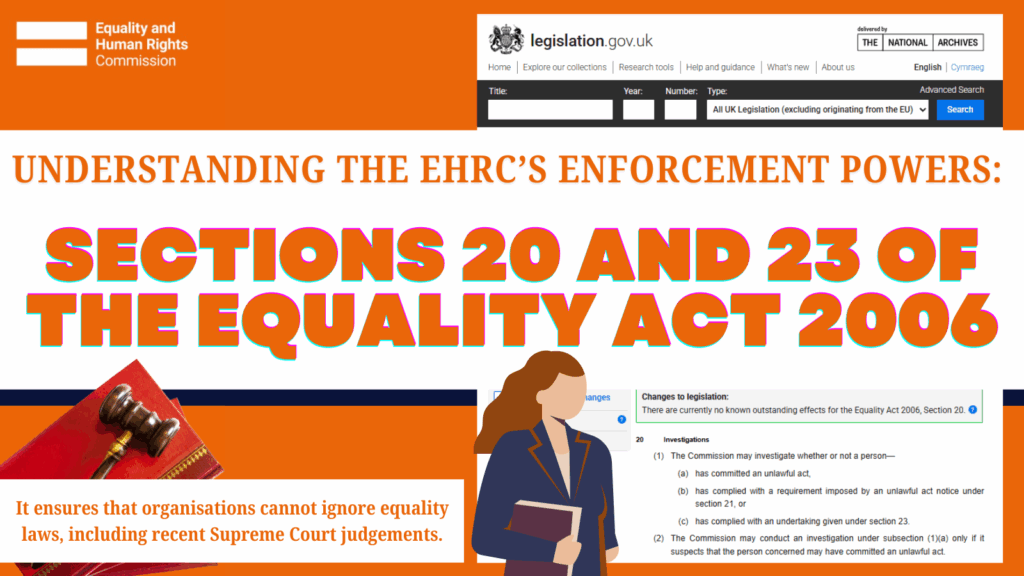
The Equality and Human Rights Commission (EHRC) plays a vital role in ensuring that organisations across Great Britain comply with equality laws, such as the Equality Act 2010. With recent Supreme Court rulings—such as the April 2025 decision clarifying the definition of “woman” under equality law—many individuals and organisations are looking to the EHRC to enforce compliance. The EHRC has unique powers to investigate and address breaches of equality law, primarily through Section 20 and Section 23 of the Equality Act 2006. This article breaks down what these sections mean, how they work, and their implications for enforcing equality laws, including the recent Supreme Court judgement.
What is the EHRC and Its Role?
The EHRC is an independent body established under the Equality Act 2006 to enforce equality laws and protect human rights in Great Britain. It works to ensure that individuals and organisations adhere to the Equality Act 2010, which prohibits discrimination based on protected characteristics like sex, race, disability, and more. The EHRC can act proactively, meaning it doesn’t need to wait for a complaint to investigate potential breaches. This is particularly important in light of recent legal developments, such as the Supreme Court ruling that has reaffirmed the definition of “woman” in equality law, impacting areas like sports, housing, and employment.
The EHRC’s enforcement powers are outlined in the Equality Act 2006, with Sections 20 and 23 being two of its most significant tools.
Section 20: Investigating Breaches of Equality Law
What is Section 20?
Section 20 of the Equality Act 2006 gives the EHRC the authority to conduct formal investigations when it suspects that an organisation has committed an “unlawful act” under equality law. This could include discriminatory practices, such as failing to provide equal opportunities in employment, excluding women from female-only spaces, or neglecting the needs of vulnerable groups, like survivors of domestic abuse in housing.
How Does It Work?
- Triggering an Investigation: The EHRC can start an investigation if it has reasonable grounds to believe an organisation has breached equality law. For example, if a sports body allows males to compete in female-only categories at the grassroots level (contrary to the Equality Act 2010 and the Supreme Court ruling), the EHRC might investigate.
- The Investigation Process: The EHRC gathers evidence by requesting documents, interviewing witnesses, and inspecting premises. This process is thorough and can be disruptive to the organisation under scrutiny.
- Outcomes: If the investigation confirms a breach, the EHRC can: Issue a notice under Section 21 of the Equality Act 2006, identifying the unlawful act and requiring corrective action. Apply to a court for an injunction to enforce compliance, with the potential for unlimited fines if the organisation does not comply.
Why is Section 20 Important?
Section 20 allows the EHRC to tackle systemic discrimination proactively, without relying on individual complaints. This is crucial for addressing widespread issues, such as sports organisations failing to protect female-only categories (as highlighted by organisations such as the Women’s Rights Network) or housing associations neglecting repairs for vulnerable women. It ensures that organisations cannot ignore equality laws, including recent Supreme Court judgements.
Where Can You Learn More?
- Read the full text of Section 20 in the Equality Act 2006: Equality Act 2006 – Section 20
- Explore the EHRC’s enforcement powers: EHRC Who We Are.
Section 23: Encouraging Compliance Through Agreements
What is Section 23?
Section 23 of the Equality Act 2006 allows the EHRC to enter into legally binding agreements with organisations suspected of breaching equality law. Known as “Section 23 agreements,” these are a voluntary alternative to a formal investigation, encouraging organisations to address issues collaboratively.
How Does It Work?
- Initiating an Agreement: The EHRC approaches an organisation if it believes there may have been a breach of equality law. For instance, if the Women’s Institute continues to admit male trans women into a women-only organisation despite the Supreme Court ruling, the EHRC might propose a Section 23 agreement.
- The Agreement Process: The organisation agrees to an action plan, which might include steps like revising policies, conducting equality training, or performing audits to ensure compliance with equality law. The EHRC monitors the organisation’s progress.
- Enforcement: Section 23 agreements are legally enforceable. If the organisation fails to meet the terms, the EHRC can apply for a court injunction to enforce the agreement or resume a formal investigation under Section 20.
Why is Section 23 Important?
Section 23 agreements offer a less adversarial approach than a full investigation, allowing organisations to avoid reputational damage while still addressing equality issues. They are particularly useful for organisations that may not have intended to discriminate but have practices that inadvertently breach equality law. For example, a housing association accused of neglecting repairs for domestic abuse survivors could sign a Section 23 agreement to prioritise repairs and ensure non-discriminatory practices.
Where Can You Learn More?
- Read the full text of Section 23 in the Equality Act 2006: Equality Act 2006 – Section 23
How Do These Sections Apply to the Supreme Court Judgement?
The Supreme Court ruling in April 2025 clarified the definition of “woman” under the Equality Act 2010, emphasising that sex-based rights must be protected in areas like sports, housing, and employment. This has significant implications for organisations, as failure to comply could lead to EHRC enforcement action.
- Section 20 in Action: If a sports organisation, such as parkrun or swimming, continues to allow males into female-only categories at the grassroots level (contrary to the Equality Act 2010), the EHRC could launch a Section 20 investigation. This might involve gathering evidence of discriminatory practices and issuing a notice to enforce compliance.
- Section 23 in Action: Alternatively, the EHRC might offer a Section 23 agreement to encourage the organisation to revise its policies voluntarily.
Summary of Key Differences
| Aspect | Section 20 (Investigations) | Section 23 (Agreements) |
|---|---|---|
| Nature | Formal investigation into suspected unlawful acts | Voluntary, legally binding agreement |
| Trigger | Reasonable suspicion of a breach | Concerns about potential breaches |
| Outcome | Notice of unlawful act, potential court action | Action plan to improve practices, monitored by EHRC |
| Approach | Adversarial, potentially disruptive | Collaborative, less damaging to reputation |
| Enforcement | Court injunctions for non-compliance | Court injunctions if agreement terms are breached |
Real-World Examples from Social Media
Recent discussions on X highlight the need for EHRC enforcement:
- Sports and the Supreme Court Ruling: The Women’s Rights Network (@WomensRightsNet) listed sports like parkrun and swimming as failing to protect female-only categories at the grassroots level, despite the Supreme Court ruling.
- Housing and Discrimination: @hfwhell has repeatedly raised concerns about Housing for Women and Lewisham Council, alleging discrimination against women in social housing, particularly survivors of domestic abuse.
Why Does This Matter?
The EHRC’s powers under Sections 20 and 23 are crucial for ensuring that equality laws are upheld, particularly in the wake of significant legal rulings like the Supreme Court judgement. These tools allow the EHRC to address systemic discrimination, protect vulnerable groups, and encourage organisations to adopt best practices. Whether through a formal investigation or a collaborative agreement, the EHRC can hold organisations accountable, ensuring that women’s rights—and the rights of all protected groups—are safeguarded.
If you believe an organisation is breaching equality law, you can contact the EHRC to raise your concerns. Together, we can work towards a fairer, more equal society.
Re-cap:
- If organisations fail to comply with the judgement or equality laws, the EHRC can initiate a Section 20 investigation to examine suspected unlawful acts, per their enforcement powers
- The EHRC may offer a Section 23 agreement, allowing organisations to voluntarily comply with equality laws instead of facing further investigation, with EHRC monitoring compliance
- For public sector breaches, such as non-compliance with the Equality Act 2010 Specific Duties, the EHRC can issue a compliance notice and apply to the High Court or Court of Session in Scotland for enforcement
- The EHRC can apply to courts for injunctions to prevent breaches of the Equality Act, with potential unlimited fines for non-compliance, as highlighted in a House of Commons report
- The Supreme Court ruling has sparked debate, with TransActual calling it “devastating” for trans rights, while EHRC’s Baroness Falkner labelled it a “victory for common sense,” indicating potential enforcement challenges.
Further Reading
- To understand the Equality Act 2010, which the EHRC enforces, you can refer to the legislation text:
Equality Act 2010 - Read the full text of Section 23 in the Equality Act 2006: Equality Act 2006 – Section 23
- Read the full text of Section 20 in the Equality Act 2006: Equality Act 2006 – Section 20
- Explore the EHRC’s enforcement powers: EHRC Who We Are.
- For a broader understanding of the EHRC’s role and powers, see the Wikipedia entry on the EHRC:
Equality and Human Rights Commission – Wikipedia - Politics Home – Baroness Kishwer Falkner @KishwerFalknerThe Supreme Court ruling on the Equality Act should cause no confusion – the judgment is a model of clarity
